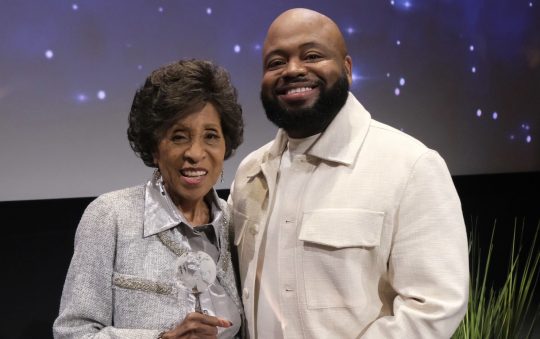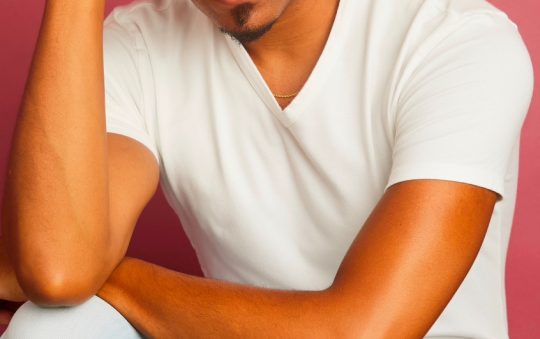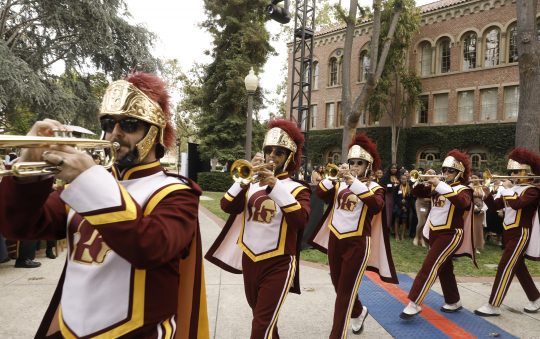Season Launch Party (Can’t Stop, Won’t Stop!): September 26, 2018 7–9 pm
The California African American Museum (CAAM) announced today that it will open four new exhibitions in fall 2018, including two original exhibitions that examine important chapters of African Americans history in California and solo exhibitions of new and recent works by artists Nina Chanel Abney (in conjunction with the Institute for Contemporary Art, Los Angeles) and Robert Pruitt. One of the upcoming exhibitions also includes CAAM’s first partnership with its Exposition Park neighbor, the Lucas Museum of Narrative Art, which is lending pieces from its collection.
George O. Davis, Executive Director of CAAM said, “The history of African Americans in California is vast and fascinating, and CAAM’s fall exhibitions delve into two lesser-known aspects of it: slavery in the state’s earliest days, and many years later, the 1963 Los Angeles Freedom Rally. These historical surveys, coupled with three art exhibitions, continue our trajectory of presenting engaging and eclectic offerings about African American art, history, and culture.”
CAAM’s fall exhibitions are:
Robert Pruitt: Devotion
September 12, 2018–February 17, 2019
Through drawing, sculpture, animation, and photography, Houston-born, New York–based artist Robert Pruitt illuminates connections between spiritual traditions, fictional narratives, and technology and investigates how black identity can reside at the intersection of these arenas. In his first major museum exhibition in Los Angeles, Pruitt reconnects with the religious traditions of his upbringing and explores the theme of devotion, specifically religious practices carried out with fervor and dedication. Drawings are presented as a set of sacred images, sculptures act as ceremonial objects, and an audio component—created in collaboration with trumpeter, composer, and rapper Jawwaad Taylor—suffuses the space with an introspective feeling. The exhibition incorporates a selection of works from CAAM’s permanent collection by artists who have influenced Pruitt, including Charles White and John Biggers. These additional objects also reference spirituality, and they speak to Pruitt’s connections to Los Angeles’ African American art community and to various artists from the American South.
This exhibition is curated by Mar Hollingsworth, Visual Arts Curator and Program Manager.
Nina Chanel Abney: Royal Flush
September 23, 2018–January 20, 2019
Nina Chanel Abney is at the forefront of a generation of artists that is unapologetically revitalizing narrative figurative painting. As a skillful storyteller, she visually articulates the complex social dynamics of contemporary urban life. Royal Flush—her first solo museum survey—includes paintings, watercolors, and collages created during the past ten years. Abney draws on mainstream news media, animated cartoons, video games, hip-hop culture, celebrity websites, and tabloid magazines to make paintings replete with symbols that appear to have landed on the canvas with the stream-of-consciousness immediacy of text messages, pop-up windows, or the scrolling headlines of an incessant 24-hour news cycle. By engaging loaded topics and controversial issues with irreverence, humor, and lampooning satire, Abney’s works are both pointed contemporary genre scenes as well as scathing commentaries on social attitudes and inequities.
Nina Chanel Abney: Royal Flush is organized by Marshall N. Price, Nancy Hanks Curator of Modern and Contemporary Art at the Nasher Museum of Art at Duke University in Durham, North Carolina, and is supported in part by an award from the National Endowment for the Arts. In Los Angeles it ispresented in two parts, at the Institute of Contemporary Art, Los Angeles, and the California African American Museum. CAAM’s presentation is organized by Naima J. Keith, Deputy Directory and Chief Curator.
California Bound: Slavery on the New Frontier, 1848–1865
September 26, 2018–January 21, 2019
On the occasion of the 170th anniversary of California’s admission into the Union, CAAM presents California Bound: Slavery on the New Frontier, 1848–1865, an exhibition that examines California’s under-recognized involvement with slavery in the 19th century. With powerful photographs, historical documents, and other ephemera, California Bound illuminates the state’s struggles over enslavement in an era that encompassed two wars and the establishment of California first as a territory and then a state. The exhibition highlights major historical events and untold stories of those impacted, and it considers how the state’s oscillation on enslavement produced ripple effects in America’s political structures that are still being felt today.
This exhibition is curated by Tyree Boyd-Pates, History Curator and Program Manager, and Taylor Bythewood-Porter, Assistant History Curator.
Los Angeles Freedom Rally, 1963
September 26, 2018–March 3, 2019
On May 26, 1963, Rev. Dr. Martin Luther King Jr. addressed nearly 40,000 people at Wrigley Field in South Los Angeles. Coined the “Los Angeles Freedom Rally,” it was one of the largest civil rights rallies in the country, predating the famous 1963 March on Washington by three months. The Los Angeles Freedom Rally was part of a full day of support for racial equality and attracted celebrities Dorothy Dandridge, Rita Moreno, Paul Newman, Sammy Davis Jr., Dick Gregory, and other notable supporters of King. Earlier that day, King attended First African Methodist Episcopal church and was the guest of honor for an evening reception where Los Angeles luminaries such as Marlon Brando were in attendance.
With powerful photographs, historical documents, and other ephemera, Los Angeles Freedom Rally, 1963 examines this significant civil rights gathering. It also explores howand why Wrigley Field, LA’s first baseball stadium to the Los Angeles Angels, was a crucial locale for the event. Existing from 1925 through 1969, Wrigley Field is still remembered as the place where King stated, “Birmingham or Los Angeles, the cry is always the same. We want to be free.” His efforts to desegregate and to connect Los Angeles to Birmingham helped to raise significant and desperately needed funds to assist the movement in supporting the passage of the Civil Rights Act of 1964.
This exhibition is curated by Tyree Boyd-Pates, History Curator and Program Manager, and Taylor Bythewood-Porter, Assistant History Curator.
The Notion of Family
September 26, 2018–March 3, 2019
In The Notion of Family, artworks from the nineteenth to the twenty-first centuries chart a trajectory of African American family and togetherness over generations. In a selection of historical sepia-tone photographs, groups of individuals echo a dignified and enduring sense of fellowship, while Miguel Covarrubias’s illustration Negro Mother(1927) and Jacob Lawrence’s The Birth of Toussaint(1986) reflect the timeless bond between mother and child. Traditions and gatherings to create, celebrate, play, and eat—which form an important part of the African American experience—are captured in Faith Ringgold’s The Sunflower Quilting Bee at Arles (1997) and Kadir Nelson’s Stickballers (2016). Throughout the exhibition the notion of family is expressed in numerous mediums, including photographs by James Van Der Zee, Carrie Mae Weems, and Lyle Ashton Harris; paintings by William E. Pajaud and others; and prints by Romare Bearden and John Biggers. As a whole, theseempowering images illustrate that the African American family is a model for thriving, even amid hardship. They suggest a sense of levity while also reflecting agency, love, strength, diversity, and unity from an African American perspective.
The majority of works in The Notion of Family are from the permanent collection of the California African American Museum, with additions from the Lucas Museum of Narrative Art. The exhibition is curated by Vida L. Brown, Visual Arts Curator and Program Manager, CAAM.
About the California African American Museum
CAAM explores the art, history, and culture of African Americans, with an emphasis on California and the West. Chartered by the State of California in 1977, the Museum began formal operations in 1981 and is a state-supported agency and a Smithsonian Affiliate. In addition to presenting exhibitions and public programs, CAAM houses a permanent collection of more than four thousand works of art, artifacts, and historical documents, and a publicly accessible research library containing more than twenty thousand volumes.
Visitor Information
Admission to the California African American Museum is free. Visit caammuseum.org for current exhibition and program information or call 213-744-7432 for tours or additional assistance.
Hours: Tuesday–Saturday 10 a.m.–5 p.m., Sunday 11 a.m.–5 p.m. Closed Mondays and national holidays. The California African American Museum is located in Exposition Park at the corner of Figueroa Street and Exposition Boulevard, west of the 110 (Harbor) Freeway. Easy parking is available for $12 (cash only) at 39thand Figueroa Streets. The Metro Expo line stop Expo Park/USC is a five-minute walk through the Exposition Park Rose Garden to the Museum.






